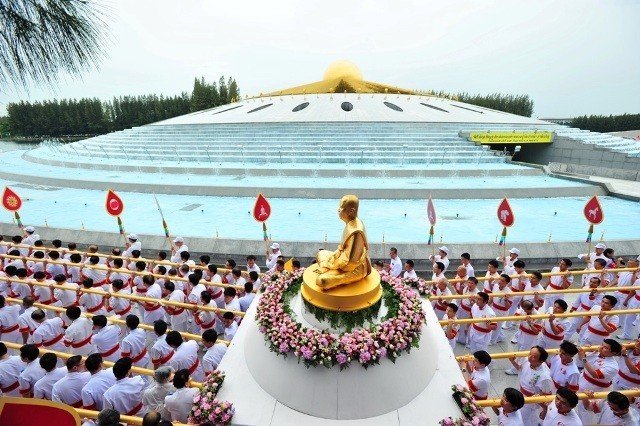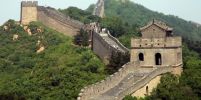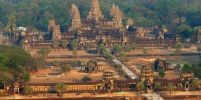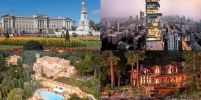เวบภาษาอังกฤษเผย!บทสรุปที่ยอดเยี่ยม:กรณีศึกษาเกี่ยวกับวัดพระธรรมกายจากภาคีไทยเพื่อสิทธิมนุษยชน
The people I respect most in the Thai human rights and prodemocracy movement all tell me that defending Wat Phra Dhammakaya [Phra Dhammakaya Temple] is the most important Thai human rights issue at the moment: http://winne.ws/n12123
By Ann Norman
The people I respect most in the Thai human rights and prodemocracy movement all tell me that defending Wat Phra Dhammakaya [Phra Dhammakaya Temple] is the most important Thai human rights issue at the moment: That the very independence of Buddhism in Thailand is at stake; that not content with grabbing the reigns of democracy, the junta also needs to grab the reigns of Thailand’s majority religion.
The abbot and the temple have been accused of money laundering, encroachment on park land, and a wide range of building code violations. The fact, that the charges are so random and unrelated, that they seem minor relative to the many obvious crimes in Thailand that are never investigated (including crimes by other prominent monks), and that this most-wanted abbot is so old and sick that he may die before this is ever resolved, makes one instantly suspect the charges are trumped up and politically motivated. Official complaints against the temple are also entangled with religious objections about correct Buddhism because in Thailand state and religion are not entirely separate. Because it is so complicated, I first tried to pass off the job of formulating a response to a Thai colleague. Then last night, I was alerted that the temple was once again surrounded by hundreds of police, while devotees sat in protest to block them if they tried to arrest their abbot. Given Thailand’s history of disastrous responses to unarmed protesting citizens, this is a worrisome situation. If I can’t make a serious effort to understand why the temple is being threatened with military force and under constant siege, how can I ask other Westerners to also care about these Thai human rights issues?
For the non-Thai, audience, it’s best to first address the big elephant in the room: Why is the Phra Dhammakaya temple shaped like a flying saucer? I know it shouldn’t matter, but if we can’t get past jokes about the flying saucer, we aren’t going to be able to help. It turns out, the temple’s website actually has a page addressing this frequently asked question: “[W]hen the Buddha first appointed the shape of all cetiyas, he folded his robes into a square shape and stacked them all together from largest to smallest. He then turned his alms bowl upside down over the folded robes, and said that that is the shape for a stupa-shaped cetiya. . . . [T]he shape [of the temple]. . . is to mirror the same traditional shape given to us by the Lord Buddha, and to symbolise the rising sun, spreading love and kindness, spreading peace to the whole world.”
The temple’s English-language website is neat and clean and addresses the reader in perfect, clear, and familiar-sounding English, as you can read above. This is in fitting with the temple’s modern style which tries to reach a broader audience for Buddhism, using all the advantages of technology such as satellite television and distance learning. It also is heavily involved in academic Buddhism, organizing conferences, and translating and archiving ancient Sanskrit texts in modern searchable formats. It is important to understand that this temple is very international with branches in the United States, Japan, and Taiwan and some of my friends are members. The temple was founded less than 50 years ago as a meditation center (specifically mediation aiming at tranquility of mind), and grew rapidly because of the popularity of its teachings. As of 2006 there were an estimated one million followers worldwide. The acres and acres of devotees you see in the pictures are just there for the day or for a weekend retreat.
They are there to learn and practice mediation. They are considered members, but it is what we in the West would consider an informal membership. They are devotees of a particular style of Buddhism. The Temple is controversial for a variety of reasons having to do either with style and emphasis within Buddhism (distinctions that will fail to scandalize the outsider to Buddhism) or practices (such as meditation and honoring of deceased leaders) that can look scary to Western non-Buddhists but occur regularly in the Thai society. None of these aspects can legitimize official harassment of this particular sect of Buddhism. (I should add, even in my Western nonreligious subculture, many are becoming interested in the practice of meditation and mindfulness, and Wat Phra Dhammakaya is interested in teaching these secular foreigners.) But whether we ever decide to get personally involved in this religion or try out its meditation practices, we can all become concerned when a government seems to be harassing a religion on trumped up charges.
It took me all morning to read the long, long story on Wikipedia. In formulating an opinion, I confess my severe limitations and invite correction from Thai experts. However in watching Thailand, I have become familiar with a particular pattern and this story certainly seems to fit that pattern: The powers-that-be perceive some small threat to their power and focus all their energies on discrediting and destroying that enemy using any flimsy excuse.
In 1999, the temple’s Abbot Phra Dhammachayo was charged with fraud and embezzlement for holding donations of land in his name. The temple defended that it was the intention of donors to give the land to the abbot and that it was not against the law for the abbot to own land. The Sangha Council (a religious governing body) around this same time was pressured into also investigating the abbot, but before they could finish their investigations, the secular government’s Ministry of Education went ahead and pressed charges against the abbot over a point of religious doctrine. This led to the temple countersuing the government for malicious prosecution. The Abbot eventually divested himself of the land after much delay and legal maneuvering. Two other charges were also raised, but by 2006, the Attorney General dropped all charges saying that pursuing the case would only create division in society and was not conducive to public benefit.
After the 2014 coup, as part of the various junta initiatives to change society, there was an National Reform Council investigation instigated by the monk Pra Buddha Issra into the assets of the Sangha Council and it was found that the Wat Pra Dhammakaya had received donations that had been embezzled from a credit union. The temple countered that they have no way of knowing whether donations come from embezzlement. Buddha Isra also tried to reopen the 1999 case involving the land once held by the abbot. Buddha Issra had been involved in, and was a cheerleader for the 2014 coup, and is the fascist monk who led a rally outside the US Embassy featuring many nasty, but hilariously misspelled posters, denouncing US Ambassador Glyn Davies. Glyn Davies was vilified on that occasion for expressing US concern about the “lengthy and unprecedented prison sentences handed down by military courts” for lese majesty (insulting royalty). Davies tried to gently point out the irony of a loud noisy protest AGAINST free speech.
Why were all the accusations and investigations into Wat Phra Dhammakaya and its abbot stirred up a second time? It seems that Buddha Issra was out to torpedo the appointment of another monk, Somdet Chuang, as Supreme Patriarch of the Buddhist Sangha—the head of all the monks in Thailand. Somdet Chuang was closely associated with Abbot Phra Dhammachayo (Somdet Chuang had ordained Abbot Phra Dhammachayo). Somdet Chuang had been already been nominated by the Buddhist Sangha (a religious governing body) to be Supreme Patriarch, but the supreme patriarch is formally appointed by the King on the advice of the Prime Minister with the approval of the Supreme Sangha Council. So both the King and the Prime Minister can potentially make, and have in the past made, various excuses to delay an appointment that is not in their interest. It seems that every time a candidate from the larger more popular order is in line for this position, the King or Prime Minister have stalled the appointment, preferring an appointee from a smaller more elite branch of Buddhism arising from a reform of King Mongut in the 1800s. Buddha Issra in fact, campaigned against the appointment of Somdet Chuang at the same time as trying to discredit Abbot Pra Dhammachayo.
The Buddhist Protection Center, a Red Shirt-oriented network, organized a large demonstration of more than 1,000 monks on February 2016 to demand that the junta not get involved in the appointment of the Supreme Patriarch. This issue is one of the very few issues in Thailand over which people seem willing to come out and protest in large crowds despite the junta’s strict rules against political gatherings.
Also, the Phra Dhammakaya temple is just gigantic, and if all the followers do is sit and meditate, and passively resist police orders when the police try to enter the temple, this is scary for the ruling junta. Here is one very visible area where threats of force don’t seem to matter. The groups is willing to commit civil disobedience for the principle that the government should not be harassing their temple or any temple, and it should stay out of religion.
Some propose that a good analogy to the harassment of Wat Phra Dhammakaya is the persecution of the Falun Gong spiritual practice in China. According to Wikipedia, Falun Gong is a “discipline combining slow-moving exercises and meditation with a moral philosophy centered on the tenets of truthfulness, compassion and tolerance” that began in 1992. “Following a period of rapid growth in the 1990s, the Communist Party launched a campaign to ‘eradicate’ Falun Gong on 20 July 1999.” The government may have been frightened by a peaceful demonstration of 10,000 Falun Gong practitioners in Beijing. “Falun Gong practitioners in China are reportedly subject to a wide range of human rights abuses: hundreds of thousands are estimated to have been imprisoned extrajudicially, and practitioners in detention are subject to forced labor, psychiatric abuse, torture, and other coercive methods of thought reform at the hands of Chinese authorities. As of 2009, human rights groups estimated that at least 2,000 Falun Gong practitioners had died as a result of abuse in custody. Some observers put the number much higher, and report that tens of thousands may have been killed to supply China’s organ transplant industry.”
This is almost too horrific to be believed, but looking back at my own experience, I understand how it can go completely under the radar of Western concerns. I confess I already met a large group of Falun Gong human rights protesters outside the UN, when I was there with Thai people protesting dictatorship and lese majesty in Thailand. They wore matching yellow shirts and seemed strangely calm and serene, and performed slow-moving exercises, and tried to give me literature about Falun Gong. I am ashamed to say now, I paid no attention and learned nothing about their cause. I realize now it was my own prejudice against strange-to-me religions that blinded me to the seriousness of their situation.
I warn myself to never so dismissive again as I pick my human rights causes. Let’s keep an eye on the situation at Wat Dhammakaya and stand up for religious freedom and police restraint.
Originally published on Thai Alliance for Human Rights at http://tahr-global.org/?p=32050
ที่มา http://freedomwatchinternational.org/its-not-a-spaceship/












